The NVIDIA GeForce GTX 650 Ti Review, Feat. Gigabyte, Zotac, & EVGA
by Ryan Smith on October 9, 2012 9:00 AM ESTPower, Temperature, & Noise
As always, we’re wrapping up our look at a video card’s stock performance with a look at power, temperature, and noise. Unlike GTX 660, GTX 650 Ti does not have GPU boost, which means the GTX 650 Ti’s load voltage is fixed at a single value. This is more important for overclocking, but because NVIDIA is not trying to min-max performance by sacrificing some power consumption, it allows the GTX 650 Ti to really turn down its power consumption. As a reminder, NVIDIA’s TDP here is 110W, with no power target (though NVIDIA throws around a “typical” number of 80W).
| GeForce GTX 650 Ti Series Voltages | |||||
| Ref GTX 650 Ti Load | EVGA GTX 650 Ti Load | Zotac GTX 650 Ti Load | Gigabyte GTX 650 Ti Load | ||
| 1.087v | 1.05v | 1.087v | 1.087v | ||
Without GPU boost voltages are quite low for desktop GeForce 600 cards. Instead of spiking at 1.175v we’re seeing a range from 1.05v to 1.087v. Meanwhile the idle voltage is typical for a GK106 card at 0.875v.
While we’re on the subject of voltages, it’s worth noting that while NVIDIA doesn’t have GPU boost active, this doesn’t mean they’ve thrown away Kepler’s power management system. Specifically there’s still a hard 1.175v ceiling, and at high voltages NVIDIA will still step down the voltage based on temperature in order to combat leakage. When overvolting our reference GTX 650 Ti we saw voltage step downs at a relatively low 56C, and another at 74C. This only applies to overvolting though, and there’s no corresponding reduction in clockspeed in any scenario.
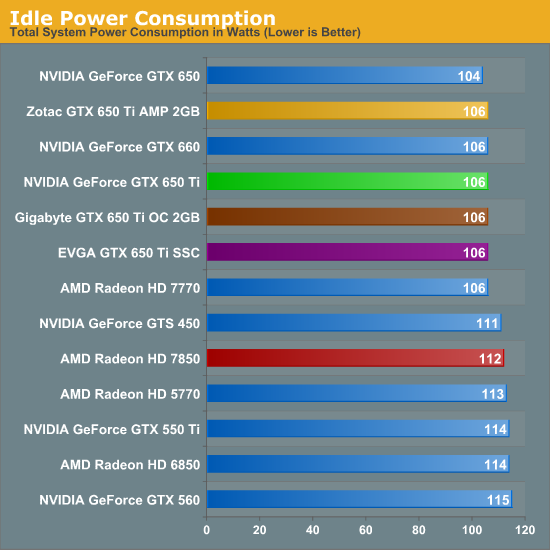
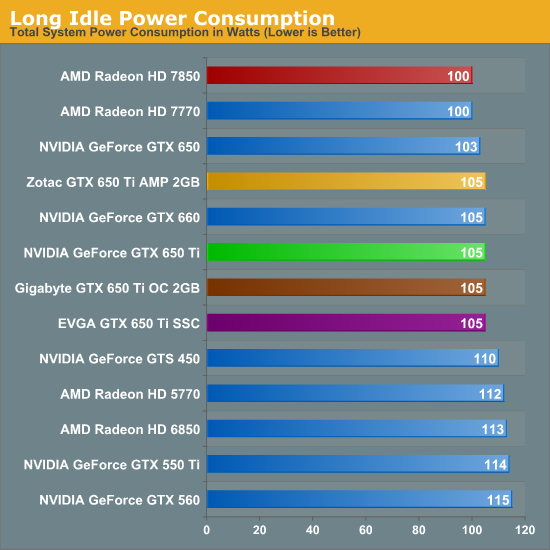
Starting as always with idle, having already seen the GK106 based GTX 660 there are no grand surprises here. Even with the disabling of some functional units the GTX 650 Ti doesn’t do any better than the full-fledged GTX 660, which is not to say that this is bad. At an NV estimated idle TDP of 5W this is still better than the 7800, and is good enough to tie the 7770. The factory overclocked cards fare no worse here either, all of which lead to our testbed hitting the same marks at the wall.
The one place NVIDIA can’t compete is in the long idle scenario with no active displays. The 7800 series still has a 5W advantage at the wall, though the benefits of something like AMD’s ZeroCore technology are not nearly as great here since the GTX 650 Ti can’t be SLI’d (and hence have a headless card).
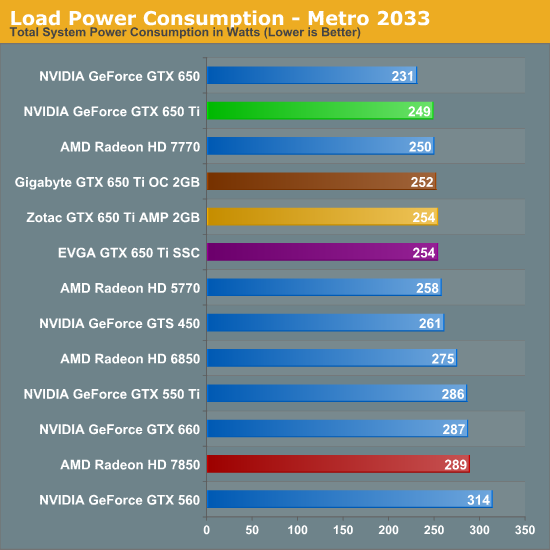
Moving on to load power consumption we’re finally seeing a test where the GTX 650 Ti has a clear architectural/design advantage over the competition. Though not strictly comparable, the 7850 has an official TDP of 150W versus 110W for the GTX 650 Ti, a difference of 40W. Meanwhile under Metro the gap between the 7850 and the GTX 650 Ti is exactly 40W (before taking into consideration PSU efficiency of course). Paper specs aside the GTX 650 Ti is clearly intended to be a lower power card than the 7850 and here it delivers. If it can’t beat the 7850 in performance then it is going to need to beat the 7850 on power consumption.
Meanwhile our factory overclocked cards present an interesting lineup. All 3 are closely clustered together in spite of the fact that the Zotac and Gigabyte cards have an extra 1GB of GDDR5 RAM to power. GDDR5 has quite the reputation for being a power hog (for a RAM), so it’s a bit surprising not to see a greater difference. The biggest driver of any power increase seems to be the overclocks themselves, leading to the marginally lower value we see for the Gigabyte card.
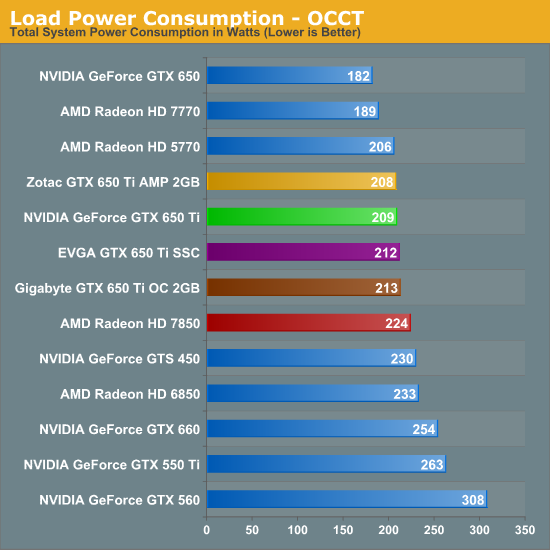
Turning to OCCT, the GTX 650 Ti doesn’t maintain the same large lead over the 7850 that it did with Metro thanks to AMD’s more aggressive throttling (and without GPU boost NVIDIA may as well not have any throttling), but reinforcing the fact that these cards are in two different power classes the GTX 650 Ti still ends up drawing less power. In fact it draws less power than the GTX 550 Ti or the GTS 450, the latter of which is not typically a high power card. Even without GPU boost – or perhaps especially without GPU boost – NVIDIA’s high power efficiency is maintained, though at a cost of rendering performance notably weaker than the immediate competition.
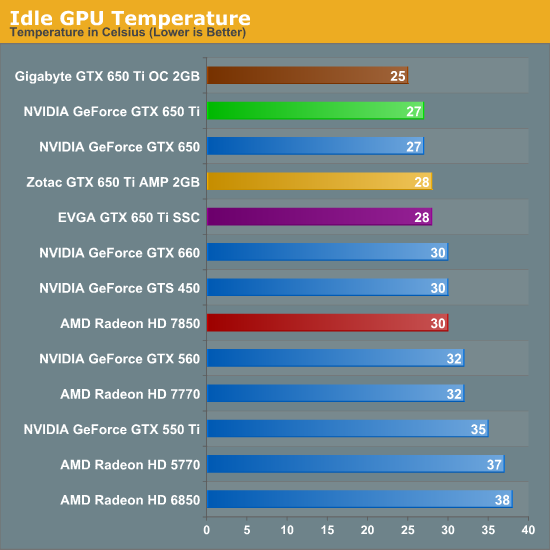
A low power GPU combined with open air coolers often leads to very low idle temperatures, and the GTX 650 Ti lives up to that tradition. It’s simply not that often that we see GPUs hit temperatures only a couple of degrees above room temperature. And in the case of Gigabyte’s card with its oversized that’s the lowest idle GPU temperature we’ve ever recorded, once more proving that there’s no kill like overkill.


Moving on to load temperatures we get to see the effectiveness of an open air cooler combined with the relatively low power consumption of the GTX 650 Ti. At 59C under Metro and 65C under OCCT our reference GTX 650 Ti holds up amazingly well, and just wait until we get to the noise readings, since this is where the GTX 650 Ti and 7850 will really stand apart. Meanwhile even with their similar designs the EVGA and Zotac cards both end up being a bit cooler, than the reference GTX 650 Ti. But the real winner is the Gigabyte card and its oversized cooler; 43C with Metro is unheard of, and 50C with OCCT is as equally impressive.

Transitioning to noise measurements we start with idle noise, where there is no great surprise as most cards have long since ceased having loud idle states. The EVGA card is a bit disappointing though, since there’s no great reason why such an open air card should be much above 41db(A).
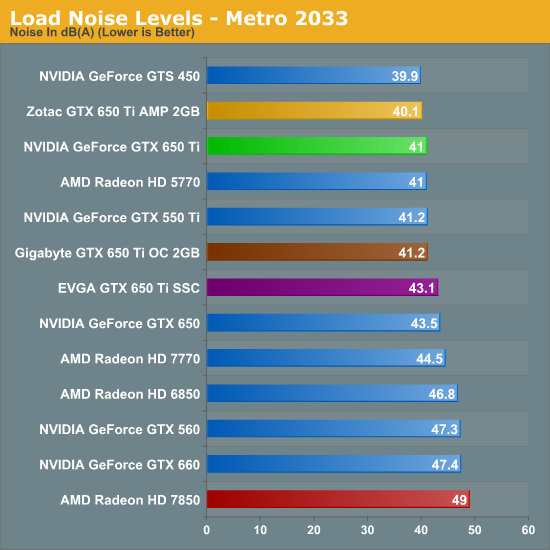
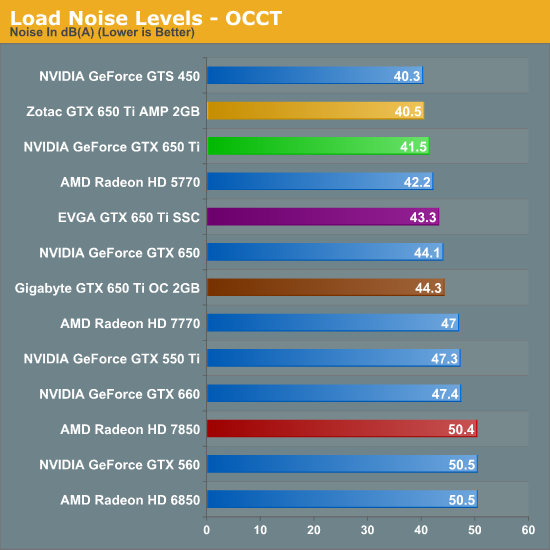
Taking a look at load noise we finally get to see the full picture. Earlier we had high praises for NVIDIA’s reference design, and this is the reason why. NVIDIA almost always hits a good balance between power, temperature, and noise, and nowhere is this more evident than with the GTX 650 Ti. Peaking at 41.5db(A) with OCCT it barely gets off of the noise floor. Meanwhile AMD’s reference 7850, complete with its blower, is almost 9dB(A) louder. Open air non-reference 7850s won’t be nearly as loud, but this is a reminder of what open air coolers can do, particularly when power consumption is low enough.
The real winner for load noise generation however is not NVIDIA’s reference design or even the Gigabyte card and its oversized cooler; it’s Zotac and their fairly plain open air cooler. Admittedly we’re looking at just a 1dB(A) difference, but if noise is crucial the Zotac card looks particularly good. Meanwhile the EVGA card, though starting out rough, doesn’t end up doing too poorly at load here. 0.3dB(A) is a tiny increase in noise over idle and it’s actually good enough to be in the middle of the pack for our retail cards.
The surprising result is the Gigabyte card, which should have the easiest time cooling. It looks like Gigabyte’s fan curve is a bit more aggressive than the rest of the GTX 650 Ti cards, which helps explain its amazingly low load temperatures, but that means there’s a noise tradeoff. Given the temperatures we’re seeing, Gigabyte was a little too aggressive with their fan curve; had they not then they could have easily swept this entire section.










91 Comments
View All Comments
Galidou - Saturday, October 13, 2012 - link
I won't be back on that thread anymore but just wait for some more stupidly stubborn reply of Cerise, that guy is just a show by himself. His level of global consiousness is below anything I have yet to see in the whole world.Sure he has some knowledge, can't deny it, it's just used in a way that seems like all that potential is totally WASTED, thrown to the garbage, buried in vomit and so on.....
Funniest shit ever.... LOL funniest comments ever..... Can't beleive it.....
Speelteveel - Wednesday, March 13, 2013 - link
Please provide these benchmarks where the oc'd 650ti "flies" past the 7850.Its not a 50 buck price diff, its 20.
Also, in these benches above, the 7850 is not overclocked.
So basically, you advocate to pay $20 less for a card that you have to overclock to get similiar performance, when the $20 more expensive card when oc'd goes into another spectrum of perfomrnace that the 650ti can't even fathom. Oc'd 7850s break even with 7870 benchmarks at 1080p.
I'm not going to link you the benchmarks you can peruse google y yourself.
the 650ti can't compare to the 7850 at all. I'm no fanboy, I just found your post dissing fanboys while blatantly being blindly biased very amusing.
vbmluis - Friday, October 12, 2012 - link
Yeah, I remember one, ATi HD 2900, heavy, big, noisy, power hungry, pricey and low performance.Jamahl - Tuesday, October 9, 2012 - link
It's not bad. It's just slow, expensive and late.Samus - Tuesday, October 9, 2012 - link
lol, that defines bad, man!But I'd argue...the only thing really wrong with this card is there isn't any good reason or it to be dual slot. with that power envelope, nVidia really could have rocked the house if this thing were a single slot, maybe even half height card (especially the 650 non-TI) because it's make a very powerful USFF/ITX PC GPU.
Aside form my dream of this card being single slot, it isn't a terrible card. The 650 Ti is mostly on par with the old 560 (which still costs more) while using less power and being half the length. Pretty much a no-brainer which one to buy there. But neither card is really worth $150-$180 when you consider you get substantially more (25-40%) performance from the 660 for just 20% more monies.
Blazorthon - Tuesday, October 9, 2012 - link
Don't forget, the 7850 comes with games and so does the 7770. Coming with a game is necessary just to compete right now. The 7770 also has some highly factory overclocked models that can inch out the 650 Ti while still being cheaper. The 650 Ti would do better at $10 or $20 lower and a MIR is a great way to accomplish that since a lot of people forget to do them anyway, but buy the card because of the after MIR price.TheJian - Tuesday, October 9, 2012 - link
Love defending AMD everywhere you go don't you :)Until you OC the 650 (or buy one already done, you act like they don't sell them on both sides OC'd) making your point moot. No phsyx either.
http://www.geforce.com/games-applications/physx
Even batman AA supports it. I don't think the 7770 comes with a current AAA title such as Assassins Creed 3 (doesn't get any more current than a game NOT even out yet). That will make a nice xmas gift to themselves for anyone buying one. Metacritic has a date of Nov20th, which is plenty of time for them to even be late a few weeks an still play over the holidays.
I'd be more than happy to have another round like we did at Toms if you'd like :) You start claiming MSAA crap again and we'll have a go...LOL
Please refrain from saying AMD is financially competitive with Intel here like over at Tom's, I don't want to waste my time burying that one again...ROFL.
abianand - Wednesday, October 10, 2012 - link
I have a slight preference from AMD cards (I don't why and I don't like having a slight preference between two equally and fairly-competing brands).Having said that....
7850 is definitely faster, but look at the power consumption of the 650Ti. Even an overclocked 650Ti draws power that just equals a normal non-overclocked 7850. So, I wouldn't call the 650Ti a bad product at all, especially when it manages to touch 30fps in almost all settings in almost all games.
Samus - Wednesday, October 10, 2012 - link
I have a preference for nVidia drivers, but these days both companies make solid chips. The real problem for AMD is all the games I play (mostly EA games) are optimized for nVidia architecture...like how Source was optimized for ATI architecture.Just how it goes.
Death666Angel - Wednesday, October 10, 2012 - link
"Until you OC the 650 (or buy one already done, you act like they don't sell them on both sides OC'd) making your point moot."Wait, so you can't OC AMD cards? Oh that's right, you can. So that is meaningless, as any OC gains from Nvidia cards will be (likely) negated by OCing the respective AMD cards.